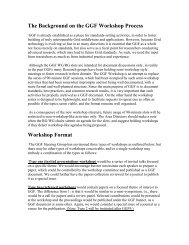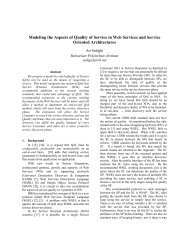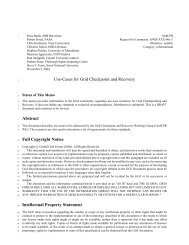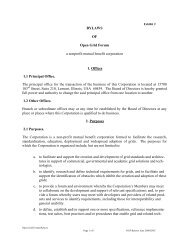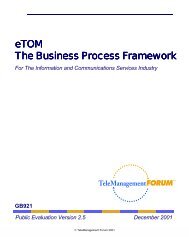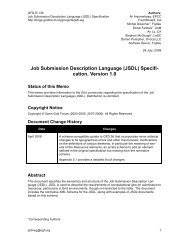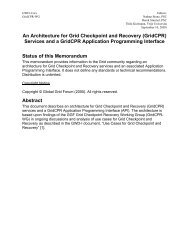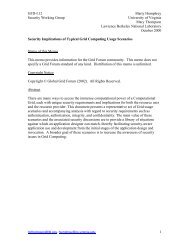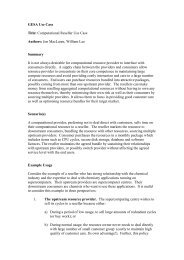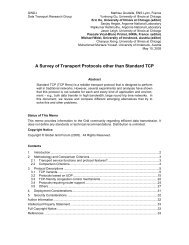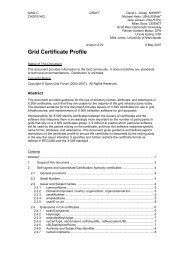DFDL plumbing
DFDL plumbing
DFDL plumbing
You also want an ePaper? Increase the reach of your titles
YUMPU automatically turns print PDFs into web optimized ePapers that Google loves.
<strong>DFDL</strong> <strong>plumbing</strong><br />
This document is a straw man proposal to try and detail some of the concepts broadly agreed at the<br />
<strong>DFDL</strong> F2F in December 2004.<br />
1 Operational elements<br />
<strong>DFDL</strong> contains the following operational elements characterised by the types that they take:<br />
●<br />
●<br />
●<br />
●<br />
Readers – takes a token of the stream and shortens the stream<br />
Writers – puts a token on a stream, lengthening it<br />
Filters – takes a stream and returns a new stream after some manipulation<br />
Functions – takes one or more simple types and returns a simple type<br />
Reader<br />
T 0<br />
T 0<br />
t 1<br />
The reader is primarily used to populate fields of the logical data. A reader consumes a stream (of a<br />
particular type T 0 ) and produces tokens (usually of a different type t 1 ). The stream is modified by the<br />
reading such that the token is said to be “consumed” and the next time a reader is applied to the<br />
stream an adjacent token will be read. Readers are work forwards through a file.<br />
A simple example of a Reader would take four bytes from an input stream and turn it into an xs:int<br />
value, such a Reader might use a parameter like “byteOrder”.<br />
Declaration<br />
The declaration of a reader defines:<br />
Binding<br />
1. reader's name<br />
2. type of token produced<br />
3. type of token stream connsumed<br />
4. a description (XSD) of all the parameter values that the reader can access<br />
The basic (Blackbox) definition of a reader, binds the declaration to an external implementation. The<br />
details of this binding will be language specific e.g. a Java binding would need to supply:<br />
Use<br />
●<br />
●<br />
fully qualified Java class: com.foo.dfdl.simpleTypes.intFromBytes<br />
Explicit binding of all the reader's parameters to fields in the class<br />
Readers are used to populate the fields of the logical model. Each element of simple type on a fully<br />
annotated <strong>DFDL</strong> Schema must have annotations specifying:<br />
●<br />
●<br />
●<br />
which reader is to be used to access this value<br />
which source stream is to be used to read the value from<br />
values for all the parameters used by this reader
Note that in general most of these values can be set at a default level and the leaves will not need to<br />
contain all these details.<br />
Proposal: The reader to use should be specified by setting a parameter value. That way the<br />
defaulting of the value can use the same mechanism as the other parameters and does not need<br />
a special one.<br />
Proposal: There should be a set of predefined parameter values which correspond to the<br />
different xsd simple types: e.g. intReader, floatReader, stringReader etc. These can be set and<br />
defaulted at the appropriate level. The reader chosen to populate an element in a logical model<br />
is therefor a function of this set of parameters and the type of the field.<br />
Proposal: There should be parameters “source” and “target” which specify the input and<br />
output streams in the current context. These will default to the base input and output streams<br />
but can be set to other streams.<br />
Writer<br />
t 1<br />
T 0<br />
T 0<br />
The Writer is symmetric with the Reader, it is used to take values from a logical model write them to<br />
a target stream. Note that this stream may be used as the input for a reader of another layer of the<br />
model (in a multi layered model).<br />
An example of a simple writer is one which would take an xs:int and write 4 bytes corresponding to<br />
its value to a stream of bytes, such a writer might use a parameter like “ByteOrder”.<br />
Declaration<br />
The declaration of a Writer defines:<br />
Binding<br />
1. Writer's name<br />
2. type of token written<br />
3. type of token stream written to<br />
4. a description (XSD) of all the parameter values that the Writer can access<br />
The basic (Blackbox) definition of a Writer, binds the declaration to an external implementation. The<br />
details of this binding will be language specific e.g. a Java binding would need to supply:<br />
Use<br />
●<br />
●<br />
fully qualified Java class: com.foo.dfdl.simpleTypes.intToBytes<br />
Explicit binding of all the Writers parameters to fields in the class<br />
Writers are used to serialize the logical model. Each element of simple type on a fully annotated<br />
<strong>DFDL</strong> Schema must have annotations specifying:
●<br />
●<br />
●<br />
which Writer is to be used to access this value<br />
which target stream is to be used to write the value to<br />
values for all the parameters used by this Writer<br />
Note that in general most of these values can be set at a default level and the leaf annotations will not<br />
need to contain all these details.<br />
Proposal: The Writer should be specified in an analogous way to the Reader in the proposals<br />
above.<br />
Filter<br />
T 0<br />
T 1<br />
The filter is used to carry out manipulations on a stream of data. It produces a new stream of values<br />
which may (or may not) be of a different type from the input.<br />
For example a filter might take an stream of characters in, and produce a new stream of characters<br />
which was the same as the input but with comments removed.<br />
Declaration<br />
The declaration of a Fliter defines:<br />
Binding<br />
1. Filter's name<br />
2. type of token stream consumed<br />
3. type of token stream written out<br />
4. a description (XSD) of all the parameter values that the Filter can access<br />
The basic (Blackbox) definition of a Filter, binds the declaration to an external implementation. The<br />
details of this binding will be language specific e.g. a Java binding would need to supply:<br />
Use<br />
●<br />
●<br />
fully qualified Java class: com.foo.dfdl.simpleTypes.intToBytes<br />
Explicit binding of all the Filter parameters to fields in the class<br />
Filters are used to define new stream sources used to populate the logical model (via Readers). A<br />
new stream source can be declared in any annotation, although it can only be used within the scope of<br />
the bindings of that annotation. The definition of a new source requires:<br />
●<br />
●<br />
●<br />
●<br />
the name of the new stream<br />
which Filter is to be used to produce the new stream<br />
which target stream is to be used to write the value to<br />
values for all the parameters used by this Writer<br />
Note that in general most of these values can be set at a default level and the leaf annotations will not<br />
need to contain all these details.
Function<br />
t 0<br />
, t 1<br />
,t 2<br />
,... t 3<br />
A function takes in zero or more values (potentially of different type) and calculates a single value.<br />
the values of all the types must be xsd simple types<br />
Question: XPath functions can use values that are XML node trees, do we need to allow this?<br />
Can we avoid it? Having this is necessary to e.g. count the number of elements in a sequence, or<br />
sum the values of a variable length sequence of elements...<br />
Declaration<br />
The declaration of a Function defines:<br />
1. Functions name<br />
2. type of values input<br />
3. type of value produced<br />
Note: Functions are defined here not to use the parameter context to calculate their values, it<br />
parameter values are needed they can be explicitly passed as inputs.<br />
Binding<br />
The basic (Blackbox) definition of a Function, binds the declaration to an external implementation.<br />
The details of this binding will be language specific e.g. a Java binding would need to supply:<br />
Use<br />
●<br />
●<br />
Functions are used in two ways:<br />
fully qualified Java class: com.foo.dfdl.simpleTypes.intToBytes<br />
The name of the method to call (the method prototype must match the prototype of<br />
the new function).<br />
1. To set the value of a parameter<br />
2. To set the value of an element in the logical model (derived data)<br />
Proposal: we have used functions to calculate the value for “runtimeOccurs” in past examples.<br />
I propose that runtimeOccurs is just a parameter (perhaps one that cannot be overridden or<br />
inhereted)<br />
2 Derived operational elements<br />
Reader<br />
New readers can be derived in the following ways:<br />
1. Whitebox definition of a reader<br />
2. Reader derived from a filter<br />
Whitebox<br />
The Whitebox definition of a reader is really a way of encapsulating an intermediate logical data layer<br />
for reuse. The definition would lay out a logical XSD/<strong>DFDL</strong> model in the usual way and a particular
element would be identified as the output element. Reading from this reader would conceptually<br />
involve populating this logical model and then accessing the value. Reading a second time would<br />
repeat the process.<br />
The new definition must be bound to a Reader declaration with matching prototype.<br />
From Filter<br />
A new reader can be defined using the “ReaderFromFilter” constructor. This takes a filter which<br />
produces a stream of X and returns a reader which manipulates the input in the same way but can<br />
supply one X at a time.<br />
The new definition must be bound to a Reader declaration with matching prototype.<br />
Writer<br />
Symetrically to readers, new Writers can be derived in the following ways:<br />
Whitebox<br />
1. Whitebox definition of a Writer<br />
2. Writer derived from a filter<br />
The Whitebox definition would lay out a logical XSD/<strong>DFDL</strong> model in the usual way these would be<br />
populated from an input stream (since this is part of the output process). Typically this process would<br />
be used for adding derived formatting information to the data so many of the fields e.g. explicit length<br />
value, would be populated by calculating function values. Once the values were calculated the outputs<br />
would be written to a designated target stream.<br />
Note: I'm not sure this works – if we have a white box reader I guess we need (and can build) a<br />
white box writer.<br />
The new definition must be bound to a Writer declaration with matching prototype.<br />
From Filter<br />
A new reader can be defined using the “WriterFromFilter” constructor. This takes a filter which takes<br />
a stream of values of type X and returns a Writer which manipulates the input data in the same way<br />
but can be supplied one X at a time.<br />
The new definition must be bound to a Writer declaration with matching prototype.<br />
Filter<br />
Filters can be derived by <strong>plumbing</strong> together existing Filters. Defining a new Filter allows such<br />
<strong>plumbing</strong> to be encapsulated for reuse. Diagramatically this looks like:<br />
MyNewFilter<br />
T 0<br />
F 0<br />
T 1<br />
F 1<br />
T 2<br />
T n<br />
F n<br />
T n+1<br />
It is tempting to suggest that a filter could be constructed by pluging a writer into a reader.<br />
However I thing that this is not the case, the output of this combination would only be a single<br />
character, we would have to use something like Mike's recursion to get a many valued stream<br />
out. However the same filter could be built by first constructing a filter from the Reader and a<br />
filter from the Writer and composing them.
Function<br />
We could declare new functions simply as expressions of existing ones. Do we need this?<br />
3 Scoping of parameters<br />
<strong>DFDL</strong> will include a large number of parameters. The parameters will define the context in which the<br />
readers and writers will read and write values. This context has to define, at any simple type in the<br />
schema:<br />
1. Which reader is to be used<br />
2. Which writer is to be used<br />
3. Value assignements for all the parameters that those readers and writers can access.<br />
4. The source and target streams that the reader and writer should use.<br />
The parameter context is to be defined by setting parameters in appinfo attributes placed on the XSD<br />
model.<br />
The number and complexity of the parameters is such that it is a requirement that we have some<br />
mechanism for defaulting the parameter values. It has been agreed that there can be defaults set in the<br />
standard, and defaults set at the top level of the document. It has also been agreed that these defaults<br />
can be overwritten on the annotation of elements and nodes with XSD simple types (where values will<br />
actually be written and read).<br />
It is desirable to be able to scope annotation bindings on branches of the XML tree, but it has been<br />
observed that this can raise significant usability issues. The difficulty is that the XML Schema tree<br />
can be composed of multiple subtrees in complicated (and recursive ways), there is also a hierarchy of<br />
type derivations as well as the hierarchy of elements and attributes. Because of this complexity<br />
arbitrary placing of the annotation values can make it difficult to decide at any point in the XML<br />
Schema tree what the values of to attributes will be. Further a single point in the Schema tree can<br />
correspond to multiple places in the instance tree, it would be possible to end up with situations in<br />
which the values of the parameters were different at these different instance sites. i.e. at a given point<br />
in the Schema tree there could be multiple values being used for a single parameter!<br />
The problem essentially is that if we scope based on the tree that the XML Schema is defining, this<br />
does not correspond to the syntactic scope of the XML Schema document.<br />
Proposal: Scope the parameter bindings should follow the syntactic scope of the XML Schema<br />
document (see below).<br />
In other words the algorithm for determining the value of a parameter at any point in the tree would be<br />
to work your way up the XML of the XML Schema, the lowest definition of that parameter that you<br />
find in that traversal is the value that you take. For example consider the following Schema:
<br />
<br />
bigEndian<br />
<br />
<br />
<br />
<br />
<br />
<br />
<br />
<br />
<br />
<br />
littleEndian<br />
<br />
<br />
<br />
<br />
<br />
<br />
<br />
<br />
In this example the parameter byteOrder is defined twice, once in the global annotation (to be<br />
bigEndian) and ones at the top of the Root element (to be littleEndian). The parameter is used in one<br />
place to read/write the integer “x” defined within the complex type “xType”.<br />
In this scoping scheme we look at the point of use then look for a definition by ascending the syntactic<br />
XML document tree. Here there are no annotations on the complex type xType so the first definition<br />
that we encounter is the global one and byteOrder is considered to be bigEndian.<br />
Notice that the annotation on Root does not override this definition because although it is above the<br />
“x” element in the instance tree, the xs:element tag to which this annotation is attached does not<br />
syntactically surround the xs:element tag in xType where the value is used.<br />
So, this scoping may have some slightly counterintuitive aspects, however it should be clear to human<br />
beings, and they can structure their schema to take advantage of the sort of scoping they require.<br />
Parameter properties<br />
Proposal: In addition to the scoping individual parameters can be declared with the following<br />
modifiers/properties<br />
●<br />
●<br />
scoped/not scoped – a parameter that is not scoped must be default, or defined at the point of use.<br />
An example might be “runtimeOccurs”<br />
dynamic/static – a dynamic parameter can be set by a runtime value a static one cannot. E.g.<br />
intReader must be statically defined.<br />
Parameter validation<br />
It is very desirable to be able to validate that the leaf parameters (those in annotations where<br />
xs:simpleTypes are to be read/written) contain only those parameters relevant to the reader and writer
at that leaf. This is difficult however because the assignment of reader and writer will depend on the<br />
value of other parameters. If the parameters upon which it depends are all statically defined and a<br />
simple scoping mechnism such as the one proposed above is used. It may be possible to define<br />
Schematron assertions that will check to ensure that all parameters that are applied are used.



